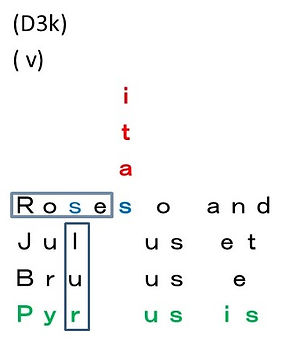Deciphering 3
“p ear” suggests us that “p” takes the shape of one ear. Then where is the other? We can find the other “p” in “Pyramus”, which can be decomposed as follows.

So we are led to ram two “p”, and make

It is said that Shakespeare died in 1616. His farewell note is dated 25, March, 1616. We will find the day and month. Remember our list of 4 persons.

Now we add this “Pear” in the sense of (D3b). Then (D3b) alters (D2b) as follows

In (D2b), only Brutus is inscribed with surname. His full name is Marcus Junius Brutus. So he has three “us” in his name. In Shakespeare’s Julius Caesar, Marcus Junius Brutus is a descendant of Lucius Junius Brutus. By which we can distinguish Brutus from this ancestor is only his first name Marcus. We will correct Brutus in the list to Marcus, and inscribe it with March as follows.

(D3d) contains March and 1616. For the day 25, we obtain it by addition, regarding Julius as 7 since his name implies 7th month in a year, and regarding R as 18 since it is 18th letter in the alphabet. Coincidence with intentional adoption of the word March is as follows. Except for the letters used for the date, we can trace this as

Actually we use March instead of Marcus for the date. So we must correct this as

The appearance of the date tells us that the death of the man of Stratford-on-Avon had been planned in advance. He is said to have died about one month later. That means he took one month to prepare his flitting. So it would not have occurred that he had been killed by someone as the figures in (D3e) and (D3f) to make the date of his death match the plan. “At end use is” is of course a reference to (D2c).

At (SB15), we have seen the addition of pear (pyrum) yields pyrus and medilla-function. Now we remark that “PPyear” is also the result of the addition of “Pear”. So we should seek pyrus and medilla-function here. We will back to (D2b).

In this arrangement, the place of letter “m” at the bottom is so cramped. Besides, the dagger “us” of “Pyramus” (see (D2a) below) is thrust at “m” (cf. (D3a)). “m” must escape from such dangerous place right now. But three daggers prevent “m” from moving just above. To escape with the least effort, “m” must ask for three neighbours, i.e. “i”,”t”,and ”a” to help “m”. They crawl out from the gap between “Rome” and “o” in a line.





Since (iii), we can find “Pyrus is” at the bottom. So medilla must alter the both of two “m” into “s” there.





Here we remember (D2b) again.

In (D2b), we see an average person Pyramus (although Ovid did not write so, this is natural consequence from the story) in the bottom, above him an aristocrat Brutus lies, the emperor Caesar upon Brutus, and the top is Rome the nation itself. So we see the social hierarchy here.
Since (iii) in (D3h), “Rome” changes to “Rose”. So this “Rose” must be Elizabethan England. In (v), we see “Roses” in the top line. Center of “Roses” must be the throne. “s” of “i,t,a,s” (we let s^ denote this “s” in the sequel) has escaped from dangerous area, and now finds out the person reigns the nation looks exactly like s^ oneself.
Now s^ tries to take the center place. It is denoted by the interchange of the center “s” and s^ with “i,t,a” as follows.


In (vii) we find the rose cross. It can be traced as “Roses slur it as rules”. The tracing course of “rules” is strange. The word is traced avoiding center s^ in bending shape. Clearly the author blames the rules in roses (i.e. royal rules) for it bends so as never to permit s^ to stay the throne.
At the left below of the cross in (vii) we have

This can be completed as

In fact it is certain that this refers to





In [15] we can find that the meaning of the word “junior”, in 1526, is juvenile or follower. After all s^ is an unrecognized follower of the queen.